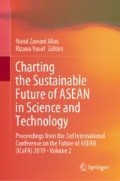Abstract
The relationship between PM2.5 pollutant distribution and urbanization, population and meteorological factors has been investigated using geographic information system (GIS) as an analysis tool. The study is focused on how the variation of PM2.5 in year 2016 and 2019 and also the factors that contribute to the PM2.5 distribution in Malaysia. The main objective of this study was to analyze the spatial variability of the pollutants by taking Peninsular Malaysia as a study area that consists of 47 monitoring station, and focus on the study area for factors that contribute to the pollutants in Selangor as a case study, by identifying the area of high concentration of PM2.5 pollutants and their relationship with urbanization, population and meteorological factors. A correlation test was performed to establish the relationship between PM2.5 pollutants, urban area, population density and temperature in Selangor station. Land use map was generated using remote sensing tool, Erdas Imagine, which performs land use classification by identifying the urbanization in study area. The main finding of this study is the comparison between spatial and non-spatial analysis approaches, which indicated that the correlation analysis and the inversed distance weighted analysis using the average of level of PM2.5 pollutants by group of few monitoring stations are relatively suitable methods for assessing the health effect of PM2.5 pollutants distribution.
Access this chapter
Tax calculation will be finalised at checkout
Purchases are for personal use only
References
Abdul Hamid H, Hanafi Rahmat M, Aisyah Sapani S (2018) The classification of PM10 concentrations in Johor based on seasonal monsoons. IOP Conf Ser: Earth Environ Sci 140(1). https://doi.org/10.1088/1755-1315/140/1/012028
Abdullah AM, Samah MAA, Tham YJ (2012) An overview of the air pollution trend in Klang Valley, Malaysia. Open Environ Sci 6:13–19. https://doi.org/10.2174/1876325101206010013
Document G, Assessment EI, Located I, Gazetted W, Approved EIA, Sites I (1987) Guidance document for the preparation of environmental impact assessment (EIA) report—Establishment of industries located within gazetted and EIA approved industrial sites, pp 1–21
Galkina EI (2014) Comparison of interpolation methods for estimating spatially aggregated pollution exposure. IEEE Sci Vis 13–14
Kanakiya RS, Singh SK, Shah U (2015) GIS application for spatial and temporal analysis of the air pollutants in urban area. Cloud Publ Int J Adv Remote Sens GIS 4(1):1120–1129. https://doi.org/10.23953/cloud.ijarsg.102
Kumar A, Gupta I, Brandt J, Kumar R, Dikshit AK, Patil RS (2016) Air quality mapping using GIS and economic evaluation of health impact for Mumbai City, India. J Air Waste Manag Assoc 66(5):470–481. https://doi.org/10.1080/10962247.2016.1143887
Zakaria UA, Saudi ASM, Abu IF, Azid A, Balakrishnan A, Amin NA, Rizman ZI (2018) The assessment of ambient air pollution pattern in Shah Alam, Selangor, Malaysia. J Fundam Appl Sci 9(4S):772. https://doi.org/10.4314/jfas.v9i4S.43
Author information
Authors and Affiliations
Corresponding author
Editor information
Editors and Affiliations
Rights and permissions
Copyright information
© 2020 Springer Nature Singapore Pte Ltd.
About this paper
Cite this paper
Talib, N., Sallehuddin, N.S.M., Sa’aid, N.A.M., Saad, N.M. (2020). PM2.5 Pollutant Distributions in Years 2016 and 2019 Using GIS Spatial Analyst. In: Alias, N., Yusof, R. (eds) Charting the Sustainable Future of ASEAN in Science and Technology . Springer, Singapore. https://doi.org/10.1007/978-981-15-3434-8_15
Download citation
DOI: https://doi.org/10.1007/978-981-15-3434-8_15
Published:
Publisher Name: Springer, Singapore
Print ISBN: 978-981-15-3433-1
Online ISBN: 978-981-15-3434-8
eBook Packages: Social SciencesSocial Sciences (R0)

